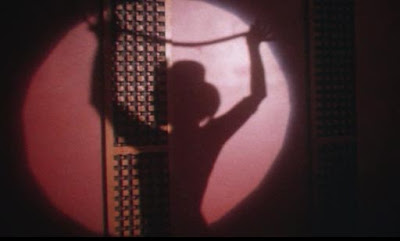One day, Mamma said: "Conrad dear,
I must go out and leave you here.
But mind now, Conrad, what I say,
Don't suck your thumb while I'm away.
The great tall tailor always comes
To little boys that suck their thumbs,
And ere they dream what he's about.
He takes his great sharp scissors out
And cuts their thumbs clean off, -and then,
You know, they never grow again."
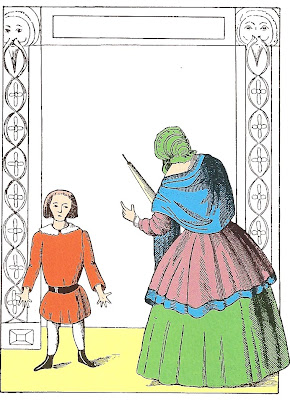
Mamma had scarcely turn'd her back
The thumb was in. Alack! Alack!

The door flew open, in he ran,
The great, long, red-legg'd scissor-man.
Oh! children, see! the tailor's come
And caught out little Suck-a-Thumb.
Snip! Snap! Snip! the scissors go;
And Conrad cries out-Oh! Oh! Oh!
Snip! Snap! Snip! They go so fast,
That both his thumbs are off at last.

Mamma comes home; there Conrad stands,
And looks quite sad, and shows his hands,-
"Ah!" said Mamma. "I knew he'd come
To naughty little Suck-a-Thumb."

The gruesome story of Little Suck-A-Thumb is from
Struwwelpeter (Heinrich Hoffman, 1845), a very popular children's book (it saw over 100 editions by 1876, originally in German) of cautionary lessons for young children, told in rhyming couplets and with a dark sense of humor that would send today's children into therapy.

Indeed, showing these often cruel and gruesome stories to children today might qualify as emotional abuse!
STRUWWELPETERCompared to Little Suck-A-Thumb, the book's namesake (translated to "Shock-Headed Peter") is relatively harmless...a boy whose refusal to observe basic grooming habits (like trimming his hair and nails) has transformed him into sideshow exhibit to be displayed for ridicule on a pedestal.
...
And the sloven, I declare,
Never once has comb'd his hair;
Any thing to me is sweeter
Than to see Shock-headed Peter.

But things turn grim in our next story. I've always been fascinated by the politics of the dinner table, in which a parent may insist that a child finish everything on his plate as an assertion of their authority, and the child may refuse to eat as a way of challenging that authority. In "The Story Of Augustus, Who Would Not Have Any Soup", a chubby little boy who always "ate and drank as he was told", rebels one day and refuses to eat his soup.

Its pretty clear whose side the author Hoffman is on, as we see Augustus waste away in an accelerated timeline.
The third day comes; Oh what a sin!
To make himself so pale and thin.
...
Look at him now on the fourth day's come!
He scarcely weighs a sugar-plum;

He's like a little bit of thread,
And on the fifth day, he was - dead!

Eat your soup, kids, or you'll die, and a soup-bowl will be placed on your grave as reminder to all visiting loved ones what a disobedient boy you were in life.
In "The Story of Cruel Frederick" we are introduced to Frederick as follows:
Here is cruel Frederick, see!
A horrid wicked boy was he;
He caught the flies, poor little things,
And then tore off their tiny wings,

He kill'd the birds, and broke the chairs,

And threw the kitten down the stairs;

And Oh! far worse than all beside,
He whipp'd his Mary, till she cried.

For all of that, Frederick's punishment seems pretty tame. He ends up getting bit by a dog he's abusing and must stay bed-ridden for a time. I guess dismemberment and death are reserved for more serious offenses.
Finally, there's "The Dreadful Story About Harriet and the Matches". Harriet can't resist the temptation to play with matches, despite warnings from her mother, and a pair of anthropomorphised kittens.
It almost makes me cry to tell
What foolish Harriet befell.
Mamma and Nurse went out one day
And left her all alone at play;
Now, on the table close at hand,
A box of matches chanc'd to stand.
And kind Mamma and Nurse had told her,
That, if she touch'd them, they should scold her.
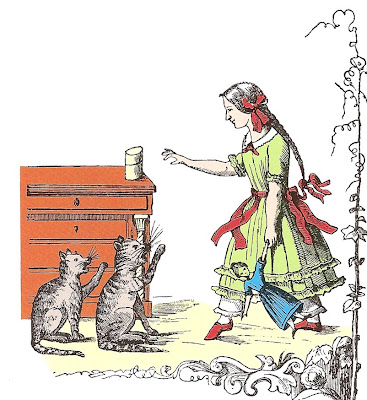
....
But Harriet would not take advice,
She lit a match, it was so nice!

...
And see! Oh! what a dreadful thing!
The fire has caught her apron-string;
Her apron burns, her arms, her hair;
She burns all over, everywhere.
...
So she was burnt, with all her clothes,
And arms, and hands, and eyes, and nose;
Till she had nothing more to lose
Except her little scarlet shoes;
And nothing else but these was found
Among her ashes on the ground.

And when the good cats sat beside
The smoking ashes, how they cried!
Me-ow, me-oo, me-ow, me-oo,
"What will Mamma and Nursy do?"
Their tears ran down their cheeks so fast;
They made a little pond at last.
 SLOVENLY BETSY
SLOVENLY BETSYIn 1911, another book of Hoffman's grim nursery rhymes, this time aimed at an American audience, was published.
 Slovenly Betsy
Slovenly Betsy, illustrated by Walter Hayn, is very much in the spirit of
Struwwelpeter and even revisits the match girl, this time named Pauline.


The issue of eating is revisted in "The Little Glutton", but unlike Augustus, who whithered away after refusing to eat, Mary's sin is constantly sneaking sweets and candies.
Oh! how this Mary loved to eat,-
It was her chief delight;
She would have something, sour or sweet,
To munch from morn till night.
She to the pantry daily stole,
And slyly she would take
Sugar, and plums, and sweetmeats, too.
And apples, nuts, and cake.

So if Augustus' punishment for NOT eating was death, what could Mary's punishment be for doing just the opposite? How about a faceful of bees!
With fright she shrieks; and tries to run,
But ah! 'tis all in vain;
Upon her light the angry bees,
And make her writhe with pain.

She's then forced to live on a diet of medicine while convalescing for several weeks.
Four weeks and more did Mary lie
Upon her little bed,
And, ah! instead of honey, she
On medicine was fed.

One of the more disturbing entries is "The Cry-Baby". You've heard the expression "crying your eyes out"?
"Oh, why are you always so bitterly crying?
You surely will make yourself blind.
What reason on earth for such sobbing and sighing,
I pray, can you possibly find?"

...
"Now do, my dear daughter, give over this weeping."
Such was a kind mother's advice.
But all was in vain; for you see she's still keeping
Her handkerchief up to her eyes.

And now the poor creature is cautiously crawling
And feeling her way all around;
And now from their sockets her eyeballs are falling;
See, there they are down on the ground.
My children, from such an example take warning,
And happily live while you may;
And say to yourselves, when you rise in the morning,
"I'll try to be cheerful today."

Another gruesome entry is "The Story of Romping Polly". Polly ignores her aunt's warning not to play roughhouse with the boys, and suffers for her disobedience.
...
"I know that you will often see
Rude boys push, drive, and hurry;
But little girls should never be
All in a heat and flurry."

But once Polly arrives at the playground, she throws right in with the rough and tumble boys, who are playing soldier.
Now see what frolic and what fun,
The little folks are after;
Away they jump, away they run,
With many a shout and laughter.

Polly breaks her leg while playing, or, as you can see by the illustration, not so much "breaks" as "severs".
...
This little girl, who spite of all
Her good old aunt had spoken,
Would romp about, had such a fall
That her poor leg was broken.
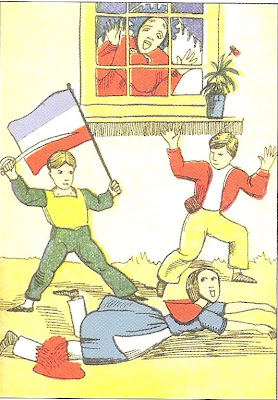
Brother parades her bleeding stump like a ghastly trophy.
See how her brother bursts in tears,
When told the dreadful story;
And see how carefully he bears
The limb all wet and gory.

Polly remains bedridden, "sad and weary".

So you may wonder what happens to Polly after she's recovered, now that she's learned her lesson to obey her elders?
...
And went on crutches, it is said,
Until she died so dreary.

"Phoebe Ann, The Proud Girl" is about an uppity child always looking down her nose at everyone else.

Holding her head so high has the consequence of stretching her neck out to freakish proportions, requiring her to shuttle her head around on a wagon.
Her head got to be so heavy to drag on,
That she had to put it on a little wagon.
So don't, my friends, hold your head too high,
Or your neck may stretch, too, by and by.

Finally, there's "Sophie Spoilall", a thankless brat who breaks all her toys.
I never saw a girl or boy
So prone as Sophie to destroy
...
Her dolls she oft tore limb from limb,
To gratify a foolish whim.

The parents decide that Christmas is the perfect time to teach Sophie a lesson.
Meantime the season of the year
For Christmas gifts was drawing near,
And Sophie doubted not that she
An ample store of them would see.
At length the happy hour was come.
The children, led into the room,
Behold, with wonder and surprise,
Three tables set before their eyes.
One is for Nelly, one for Ned,
And both with choicest treasures spread.

Nelly? Ned? But what about Sophie?
The other table is left bare,
And see, poor Sophie's standing there.
"You see, my loves," their father said,
Kriss Kringle has the difference made,
Which oft we told you that he would,
Between the naughty and the good."
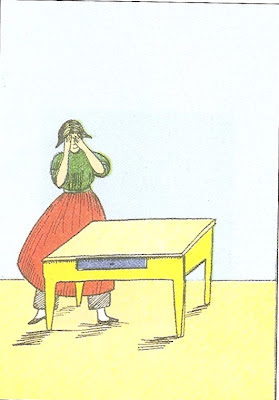 MAX AND MORITZ
MAX AND MORITZFinally we arrive at Max and Moritz, a pair of mischevious (dare I say criminal?) boys who play a series of cruel pranks before receiving their grim comeuppance. Written by Wilhelm Busch and originally published in 1871, these stories seem like a precursor to the modern comic strip.

For their first prank, Max and Moritz partake in a bit of animal cruetly when they bait the Widdow Tibbet's chickens with four peices of bread tied to the ends of a knotted string. Read the account from the original text below (English translation on the left, with original German on the right).









Next, the kids steal the chickens after the Widow has cooked them for dinner, and manage to get her dog blamed for the theft, who must now endure a beating.

In a later prank, Max and Moritz gather biting insects from a tree and release them in their Uncle Fritzy's bed.






There are several other pranks, one involving sabotaging a bridge and another planting explosives in a teacher's smoking pipe. But when they try to steal some bread at a bakery and fall into a trough of dough, it looks like they may finally get their just desserts when the baker puts the dough (along with Max and Moritz) into the oven.





You
almost feel sorry for them...


But it's a false alarm. The boys are alive, and in perfect hibernation. They eat their way to freedom, no worse for wear.

But when they press their luck trying to steal cornmeal from a mill, the farmer who catches them red-handed tosses them into the hopper...

...sealing the doom of Max and Moritz.
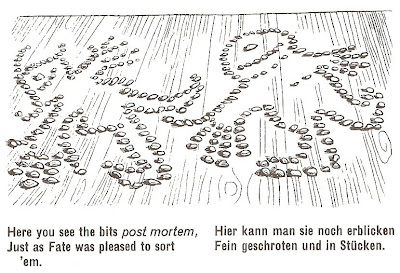
 I've previously posted rambling reminiscences about what a bigger deal TV shows and movies used to be back in the days before recordable media and on-demand streaming video made entertainment ubiquitous and disposable.
I've previously posted rambling reminiscences about what a bigger deal TV shows and movies used to be back in the days before recordable media and on-demand streaming video made entertainment ubiquitous and disposable. So even though the original broadcast of the animated adaptation of C.S. Lewis' The Lion, The Witch and The Wardrobe did not coincide with any holiday, there was a similar sense of excitement when I watched it in two parts, spread across two nights, back in April of 1979.
So even though the original broadcast of the animated adaptation of C.S. Lewis' The Lion, The Witch and The Wardrobe did not coincide with any holiday, there was a similar sense of excitement when I watched it in two parts, spread across two nights, back in April of 1979. Directed by long-time Peanuts animator Bill Melendez (he also directed the Christmas special Yes Virginia, There Is A Santa Claus), The Lion... is a reverent and engaging version of the Narnia chapter that would go on to spawn a big-budget blockbuster some 25 years later.
Directed by long-time Peanuts animator Bill Melendez (he also directed the Christmas special Yes Virginia, There Is A Santa Claus), The Lion... is a reverent and engaging version of the Narnia chapter that would go on to spawn a big-budget blockbuster some 25 years later. Don't be mislead by the cutish character designs. This adaptation takes its story seriously, as it should. No attempt is made to dumb-down the tone, and at no point do any of the characters break out into song. Aside from perhaps the Rankin Bass adaptation of The Hobbit, this was probably the most serious piece of animation I'd seen by this time.
Don't be mislead by the cutish character designs. This adaptation takes its story seriously, as it should. No attempt is made to dumb-down the tone, and at no point do any of the characters break out into song. Aside from perhaps the Rankin Bass adaptation of The Hobbit, this was probably the most serious piece of animation I'd seen by this time.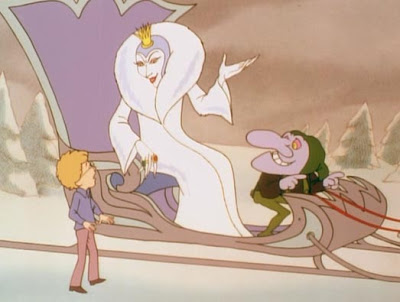 I was enthralled by scenes of the evil Queen, whose minions include all manner of monster.
I was enthralled by scenes of the evil Queen, whose minions include all manner of monster.
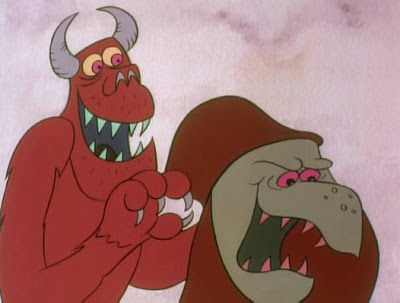


 Some scenes challenged the expectations I'd held as to the degree of evil that was allowable in an animated film. Scenes like this, in which the Queen has tied young Edmund to a tree and intends to sacrifice him with a knife.
Some scenes challenged the expectations I'd held as to the degree of evil that was allowable in an animated film. Scenes like this, in which the Queen has tied young Edmund to a tree and intends to sacrifice him with a knife. The finale, in which a gleefully vicious mob of monsters ritually kills the noble lion Aslan, is powerful, and perhaps even more effective than the live-action Disney version.
The finale, in which a gleefully vicious mob of monsters ritually kills the noble lion Aslan, is powerful, and perhaps even more effective than the live-action Disney version.
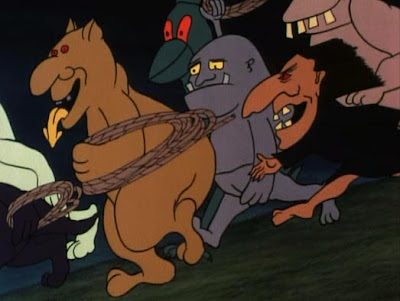





 Buy The Lion, The Witch and The Wardrobe on DVD here.
Buy The Lion, The Witch and The Wardrobe on DVD here.


















